HONDA ODYSSEY 1995 Owners Manual
Manufacturer: HONDA, Model Year: 1995, Model line: ODYSSEY, Model: HONDA ODYSSEY 1995Pages: 240, PDF Size: 2.44 MB
Page 161 of 240
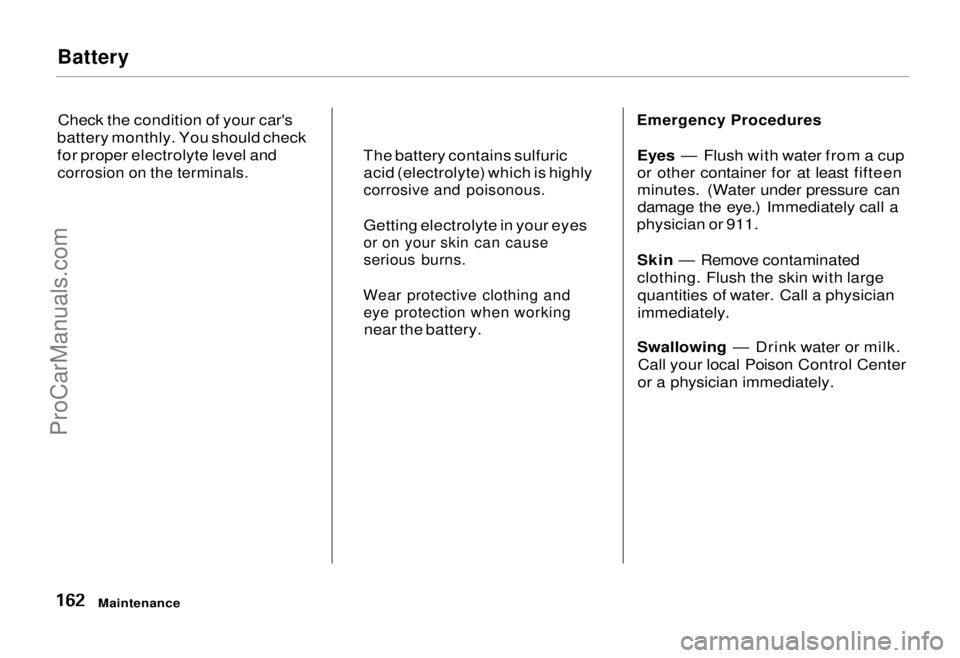
Battery
Check the condition of your car's
battery monthly. You should check
for proper electrolyte level and
corrosion on the terminals.
Emergency Procedures
Eyes — Flush with water from a cup
or other container for at least fifteen
minutes. (Water under pressure candamage the eye.) Immediately call a
physician or 911.
Skin — Remove contaminated
clothing. Flush the skin with largequantities of water. Call a physician
immediately.
Swallowing — Drink water or milk. Call your local Poison Control Center
or a physician immediately.
Maintenance The battery contains sulfuric
acid (electrolyte) which is highly
corrosive and poisonous.
Getting electrolyte in your eyes
or on your skin can cause
serious burns.
Wear protective clothing and eye protection when working
near the battery.ProCarManuals.comMain Menu Table of Contents s t
Page 162 of 240
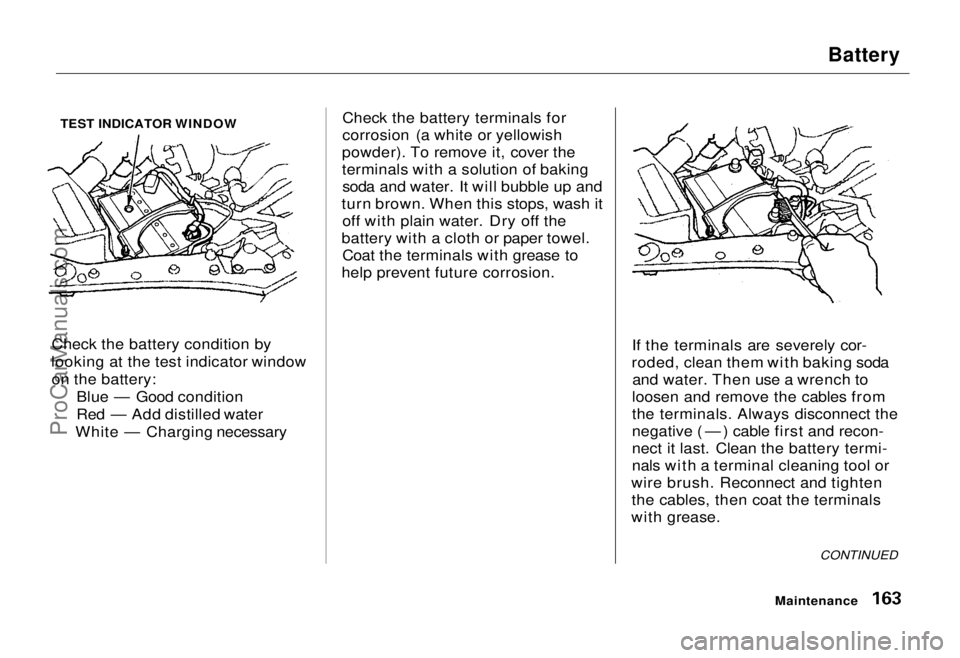
Battery
TEST INDICATOR WINDOW
Check the battery condition by
looking at the test indicator window on the battery: Blue — Good condition
Red — Add distilled water
White — Charging necessary Check the battery terminals for
corrosion (a white or yellowish
powder). To remove it, cover the
terminals with a solution of baking soda and water. It will bubble up and
turn brown. When this stops, wash it off with plain water. Dry off the
battery with a cloth or paper towel. Coat the terminals with grease to
help prevent future corrosion.
If the terminals are severely cor-
roded, clean them with baking soda and water. Then use a wrench to
loosen and remove the cables from
the terminals. Always disconnect the
negative (
—
) cable firs
t and recon-
nect it last. Clean the battery termi-
nals with a terminal cleaning tool or
wire brush. Reconnect and tighten the cables, then coat the terminals
with grease.
MaintenanceCONTINUEDProCarManuals.comMain Menu Table of Contents s t
Page 163 of 240
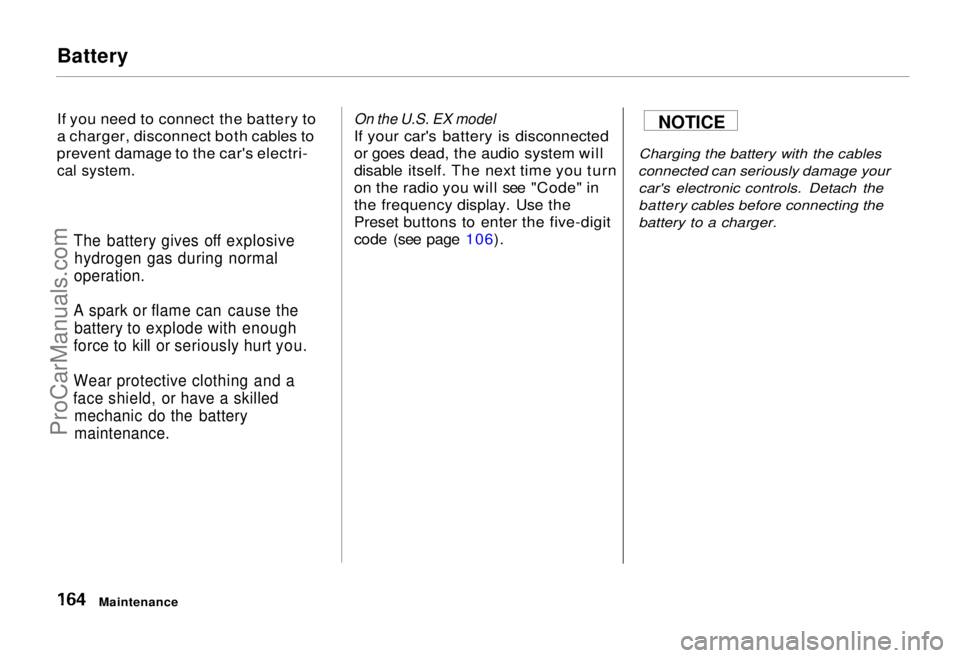
Battery
If you need to connect the battery to
a charger, disconnect both cables to
prevent damage to the car's electri-
cal system.
On the U.S. EX model
If your car's battery is disconnected
or goes dead, the audio system will
disable itself. The next time you turn
on the radio you will see "Code" in
the frequency display. Use the
Preset buttons to enter the five-digit
code (see page 106).
Charging the battery with the cables
connected can seriously damage your
car's electronic controls. Detach the
battery cables before connecting the
battery to a charger.
Maintenance
The battery gives off explosive
hydrogen gas during normal
operation.
A spark or flame can cause the battery to explode with enough
force to kill or seriously hurt you.
Wear protective clothing and a
face shield, or have a skilled mechanic do the battery
maintenance.
NOTICEProCarManuals.comMain Menu Table of Contents s t
Page 164 of 240
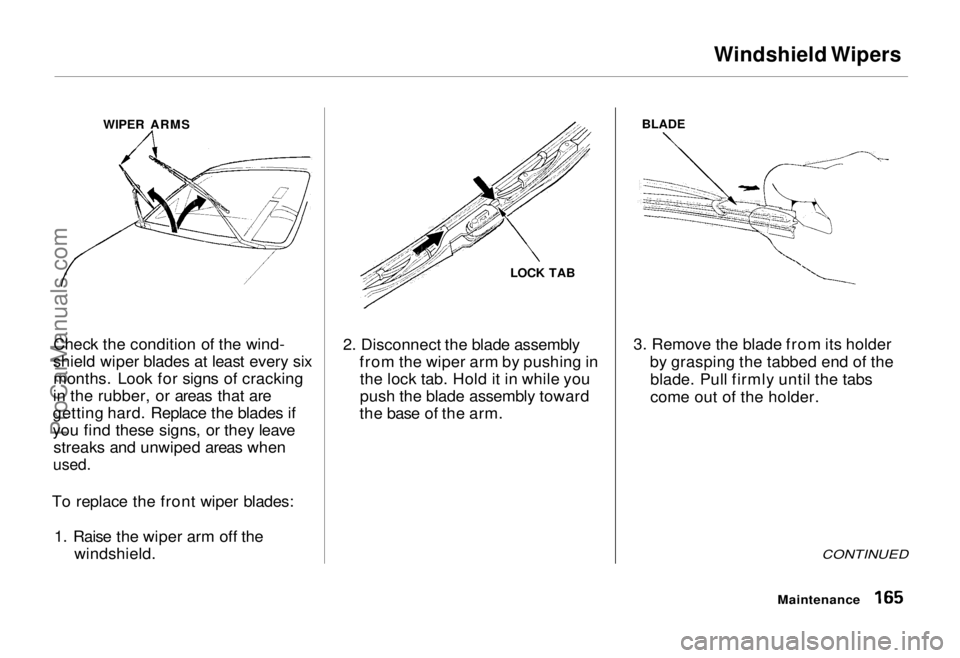
Windshield Wipers
Check the condition of the wind-
shield wiper blades at least every six months. Look for signs of cracking
in the rubber, or areas that are
getting hard. Replace the blades if
you find these signs, or they leave streaks and unwiped areas when
used.
To replace the front wiper blades: 1. Raise the wiper arm off the windshield. 2. Disconnect the blade assembly
from the wiper arm by pushing inthe lock tab. Hold it in while you
push the blade assembly toward
the base of the arm. 3. Remove the blade from its holder
by grasping the tabbed end of theblade. Pull firmly until the tabs
come out of the holder.
CONTINUED
Maintenance
WIPER ARMS
LOCK TABBLADEProCarManuals.comMain Menu Table of Contents s t
Page 165 of 240
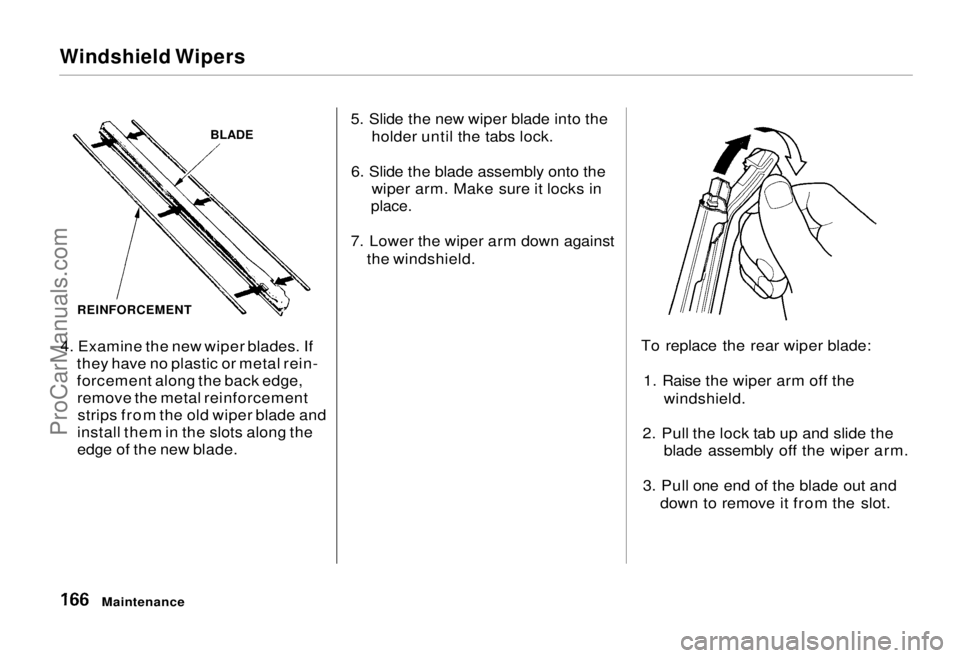
Windshield Wipers
4. Examine the new wiper blades. If they have no plastic or metal rein-
forcement along the back edge,remove the metal reinforcementstrips from the old wiper blade and
install them in the slots along the
edge of the new blade. 5. Slide the new wiper blade into the
holder until the tabs lock.
6. Slide the blade assembly onto the wiper arm. Make sure it locks in
place.
7. Lower the wiper arm down against the windshield.
To replace the rear wiper blade:1. Raise the wiper arm off the windshield.
2. Pull the lock tab up and slide the blade assembly off the wiper arm.
3. Pull one end of the blade out and down to remove it from the slot.
Maintenance
BLADE
REINFORCEMENTProCarManuals.comMain Menu Table of Contents s t
Page 166 of 240
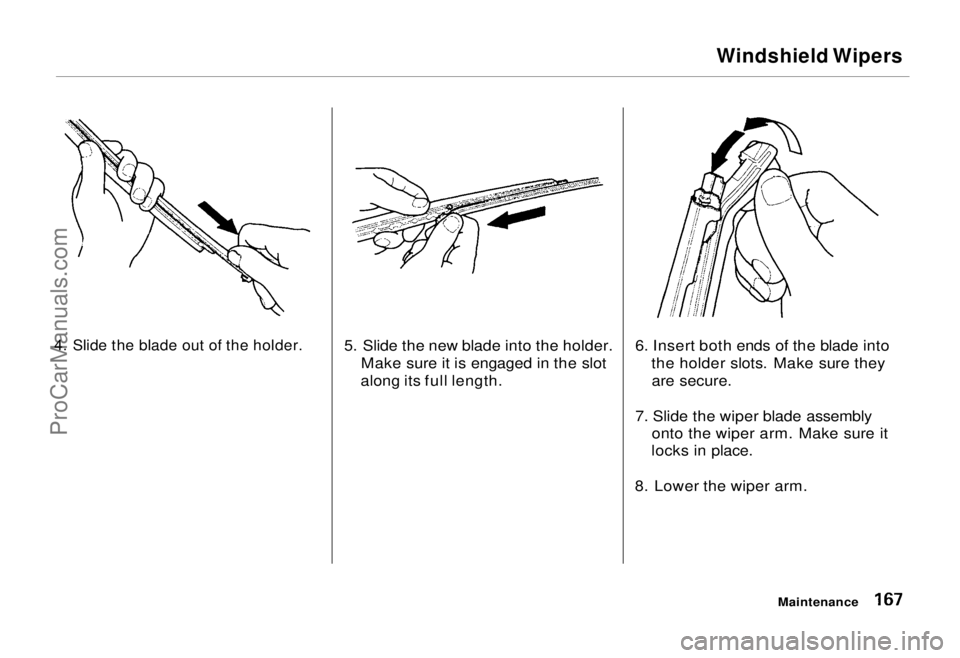
Windshield Wipers
4. Slide the blade out of the holder.
5. Slide the new blade into the holder.
Make sure it is engaged in the slot
along its full length. 6. Insert both ends of the blade into
the holder slots. Make sure theyare secure.
7. Slide the wiper blade assembly onto the wiper arm. Make sure it
locks in place.
8. Lower the wiper arm.
MaintenanceProCarManuals.comMain Menu Table of Contents s t
Page 167 of 240
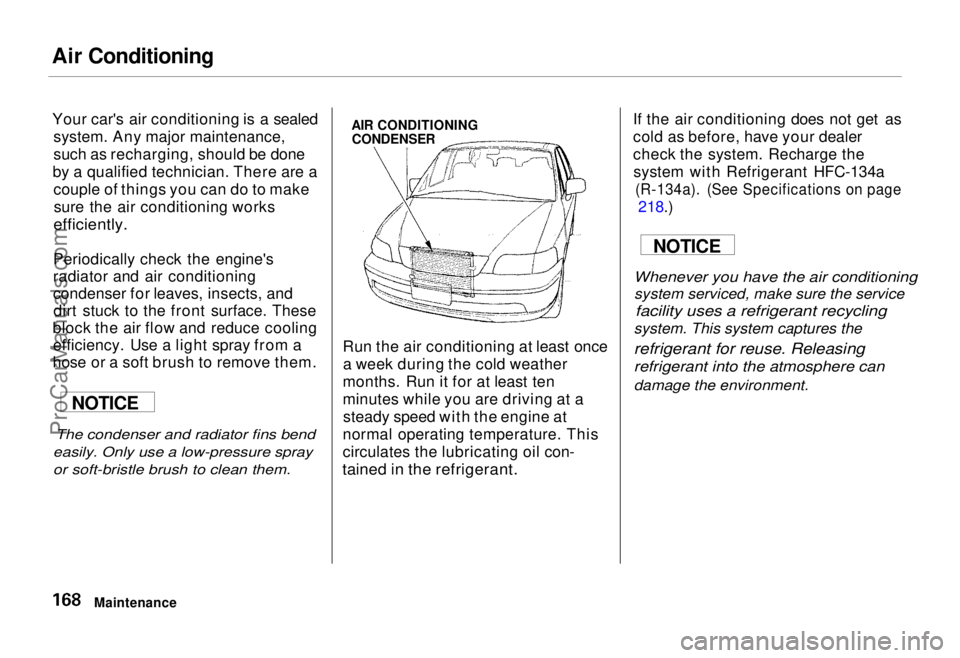
Air Conditioning
Your car's air conditioning is a sealed system. Any major maintenance,
such as recharging, should be done
by
a qualified technician. There are a
couple of things you can do to make sure the air conditioning works
efficiently.
Periodically check the engine's
radiator and air conditioning
condenser for leaves, insects
, and
dirt stuck to the front surface.
These
block the air flow and reduce cooling efficiency. Use a light spray from a
hose or
a soft brush to remove them. Run the air conditioning at least once
a week during the cold weather
months
. Run it for at least ten
minutes while you are driving at a steady speed with the engin
e at
normal operating temperature. This
circulates
the lubricating oil con-
tained in the refrigerant.
If th
e air conditioning does not get as
cold
as before, have your dealer
chec
k the system. Recharge the
syste
m with Refrigerant HFC-134a
(R-134a). (See Specifications on page
218.)
Whenever you have the air conditioning
system. This system captures the
refrigerant for reuse. Releasing
refrigerant into the atmosphere can
damage the environment.
Maintenance
AIR CONDITIONING
CONDENSER
The condenser and radiator fins bend
easily. Only use a low-pressure spray
or soft-bristle brush to clean them.
NOTICE NOTICE
system serviced, make sure the service
facility uses a refrigerant recycling
ProCarManuals.comMain Menu Table of Contents s t
Page 168 of 240
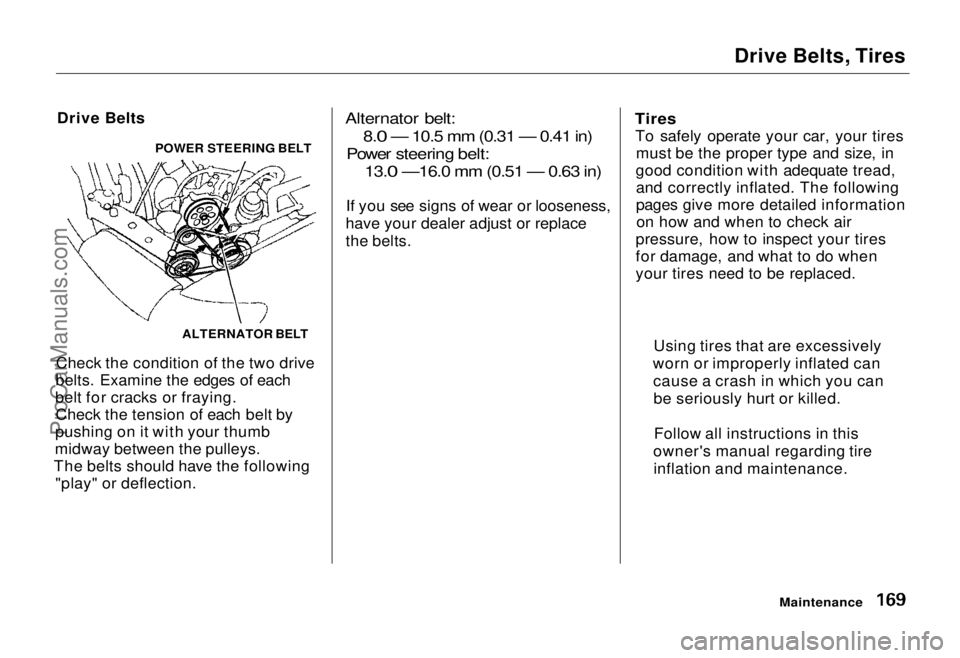
Drive Belts, Tires
Drive Belts POWER STEERING BELT
Check the condition of the two drive
belts. Examine the edges of each
belt for cracks or fraying. Check the tension of each belt by
pushing on it with your thumb
midway between the pulleys.
The belts should have the following "play" or deflection.
Alternator belt:
8.0 — 10.5 mm (0.31 — 0.41 in)
Power steering belt:
13.0 —16.0 mm (0.51 — 0.63 in)
If you see signs of wear or looseness,
have your dealer adjust or replace
the belts.
Tires
To safely operate your car, your tires must be the proper type and size, in
good condition with adequate tread, and correctly inflated. The following
pages give more detailed informationon how and when to check air
pressure, how to inspect your tires
for damage, and what to do when
your tires need to be replaced.
Maintenance
ALTERNATOR BELT
Using tires that are excessively
worn or improperly inflated can cause a crash in which you canbe seriously hurt or killed.
Follow all instructions in this
owner's manual regarding tire inflation and maintenance.
ProCarManuals.comMain Menu Table of Contents s t
Page 169 of 240
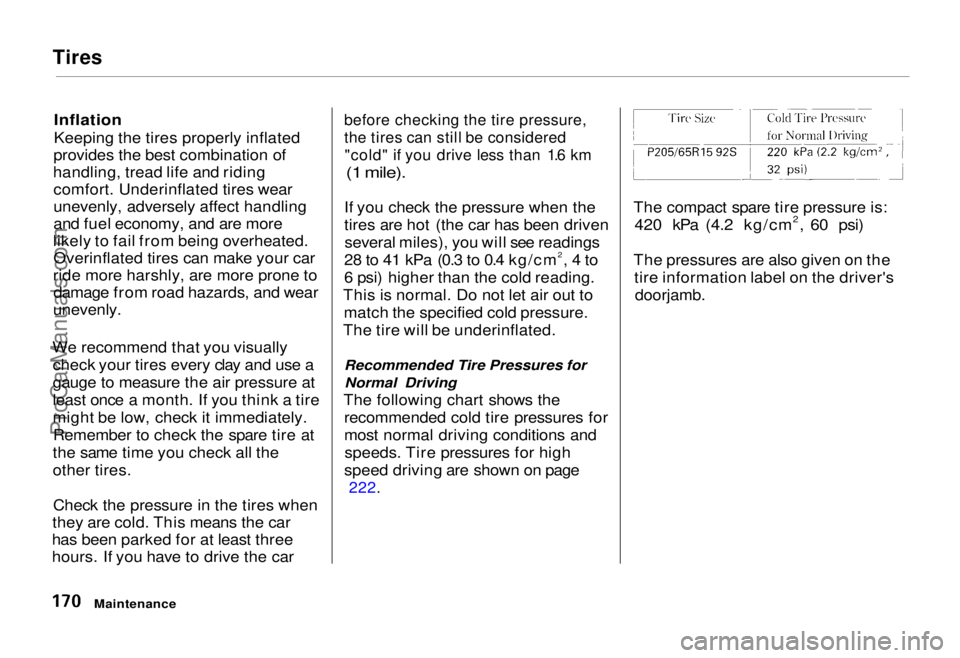
Tires
Inflation
Keeping the tires properly inflated
provides the best combination of
handling, tread life and riding comfort. Underinflated tires wear
unevenly, adversely affect handling
and fuel economy, and are more
likely to fail from being overheated. Overinflated tires can make your car
ride more harshly, are more prone to damage from road hazards, and wear
unevenly.
We recommend that you visually check your tires every clay and use a
gauge to measure the air pressure at
least once a month. If you think a tire
might be low, check it immediately.Remember to check the spare tire at
the same time you check all the
other tires.
Check the pressure in the tires when
they are cold. This means the car
has been parked for at least three
hours. If you have to drive the car
before checking the tire pressure,
the tires can still be considered
"cold" if you drive less than 1.6 km
(1 mile).
If you check the pressure when the
tires are hot (the car has been driven several miles), you will see readings
28 to 41 kPa (0.3 to 0.4 kg/cm2, 4 to
6 psi) higher than the cold reading.
This is normal. Do not let air out to match the specified cold pressure.
The tire will be underinflated.
Recommended Tire Pressures forNormal Driving
The following chart shows the recommended cold tire pressures for
most normal driving conditions andspeeds. Tire pressures for high
speed driving are shown on page
222.
The compact spare tire pressure is:
420 kPa (4.2 kg/cm2, 60 psi)
The pressure
s
are also given on the
tire information label on the driver's
doorjamb.
MaintenanceProCarManuals.comMain Menu Table of Contents s t
Page 170 of 240
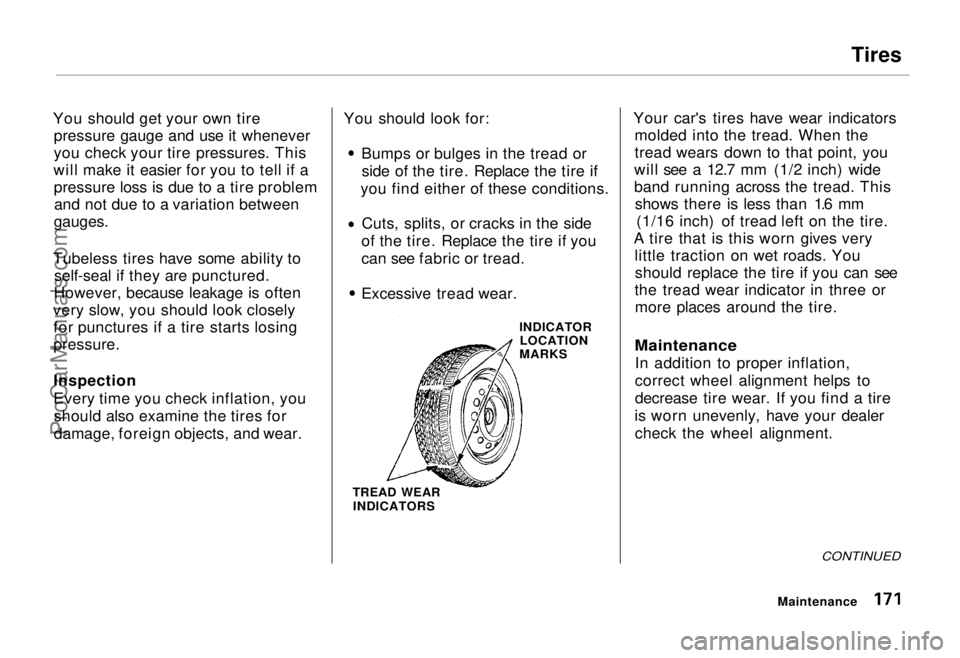
Tires
You should get your own tire pressure gauge and use it whenever
you check your tire pressures. This
will make it easier for you to tell if a pressure loss is due to a tire problemand not due to a variation between
gauges.
Tubeless tires have some ability to self-seal if they are punctured.
However, because leakage is often
very slow, you should look closely for punctures if a tire starts losing
pressure.
Inspection
Every time you check inflation, you
should also examine the tires for
damage, foreign objects, and wear. You should look for:
Bumps or bulges in the tread orside of the tire. Replace the tire if
you find either of these conditions.
Cuts, splits, or cracks in the side
of the tire. Replace the tire if you
can see fabric or tread.
Excessive tread wear.
INDICATORLOCATION
MARKS
TREAD WEAR INDICATORS Your car's tires have wear indicators
molded into the tread. When the
tread wears down to that point, you
will see a 12.7 mm (1/2 inch) wide
band running across the tread. This shows there is less than 1.6 mm (1/16 inch) of tread left on the tire.
A tire that is this worn gives very little traction on wet roads. Youshould replace the tire if you can see
the tread wear indicator in three or more places around the tire.
Maintenance
In addition to proper inflation,
correct wheel alignment helps to
decrease tire wear. If you find a tire
is worn unevenly, have your dealer check the wheel alignment.
CONTINUED
MaintenanceProCarManuals.comMain Menu Table of Contents s t